![]()
![]()
![]()
Use LEFT and RIGHT arrow keys to navigate between flashcards;
Use UP and DOWN arrow keys to flip the card;
H to show hint;
A reads text to speech;
44 Cards in this Set
- Front
- Back
|
The structure that prevents objects from moving behind the eye is the
|
conjunctiva.
|
|
|
The structure responsible for turning light impulses into nervous impulses is the
|
retina.
|
|
|
The layer of the eye responsible for providing nourishment to the eye is the
|
choroid layer.
|
|
|
The eye's shape is maintined by the
|
sclera layer and the vitreous humour.
|
|
|
The cornea is really just a transparent part of the _______ layer.
|
sclera (layer).
|
|
|
Which ligaments hold the lens in place?
|
Suspensary ligaments.
|
|
|
Which structure in the eye is reponsible for regulating the amount of light that enters the eye?
|
The iris.
|
|
|
Specialized receptors found in the retina which respond to differing light intensity but not different wave lengths of light are known as
|
rod cells.
|
|
|
Specialized receptors found in the retina which repond to different wave lengths of light, providing us with colour vision, are known as
|
cone cells.
|
|
|
The macula or fovea centralis is filled with this type of specialized receptor cells.
|
Cone cells.
|
|
|
These receptor cells provide us with good peripheral vision and ok night vision.
|
Rod cells.
|
|
|
To accomodate for a distant object our ciliary muscles will be _____ and our lens _______ to refract light onto our retina.
|
relaxed (muscles)
flat (lens) |
|
|
To accomodate for a near object our ciliary muscles will be _____ and our lens _______ to refract light onto our retina.
|
contracted(muscles)
round(lens) |
|
|
A person with nearsightedness (myopia)has difficulty seeing objects far away beacuse the lens is focusing objects __________ of the retina.
|
in front
|
|
|
A person with farsightedness(hyperopia)has difficulty seeing objects close up beacuse the lens is focusing objects __________ the retina.
|
behind
|
|
|
Myopia can be fixed by a __________ lens in front of the eye.
|
concave (lens)
|
|
|
Hyperopia can be fixed by a __________ lens in front of the eye.
|
convex (lens)
|
|
|
An uneven curvature of the lense is known as an
|
astigmatism.
|
|
|
A cloudiness in the lens that blocks light from reaching the retina is called a
|
cataract.
|
|
|
Aqueous humor not draining out correctly will cause pressure builds up in the eye and is a condition known as
|
glaucoma.
|
|
|
Severe vitamin A deficiency leads to a lack of rhodopsin, and may impair
|
night vision.
|
|
|
The pinna and auditory canal of the ear help hearing by
|
collecting and funneling sound waves.
|
|
|
The tube that equalizes pressure in the middle ear is the
|
eustachian tube.
|
|
|
The strurcture in the ear that converts sound waves into mechanical vibrations is the
|
tympanic membrane.
|
|
|
The bones in the inner ear that transfer vibrations from the tympaic membrane to the oval window are the
|
Ossicles (hammer, anvil and stirrup).
|
|
|
The ______ window releaves fluid pressure from the vibrations in the lymph of the inner ear.
|
round
(Remember, fluid can not be compressed) |
|
|
This organ, found in the inner ear, turns vibrations into nervous impulses.
|
The Organ of corti.
|
|
|
This structure helps give us a sense of balance or head position.
|
The vestibule (saccule and utricle)
|
|
|
These structures help with dynamic equilibrium.
|
The semi-cirrcular canals.
|
|
|
This nerve transmits impulses from the inner ear to the brain.
|
The auditory nerve.
|
|
|
The blind spot is caused by
|
the lack of sersory receptors due to the attachment of the ocular nerve.
|
|
|
This occures when receptor becomes accustomed to a stimulus and no longer sends impulse.
|
Sensory adaptation.
|
|
|
The two primary organs for chemoreception are the
|
nose and tongue.
|
|
|
fovea centralis or the macula.
|
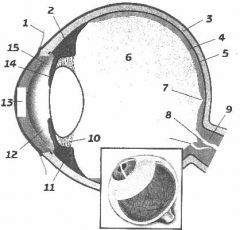
The structure labeled 7 is the
|
|
|
14 (the iris)
|
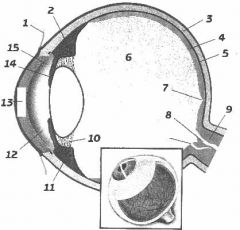
The structure that regulates the amount of light that enters the eye is labeled
|
|
|
13 (the cornea)
|
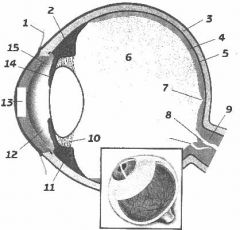
Cataracts are a clouding of the lens or the structure labeled
|
|
|
8
|
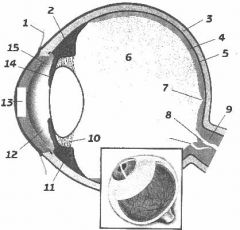
The blind spot is indicated best by this number
|
|
|
5, the choroid layer.
|
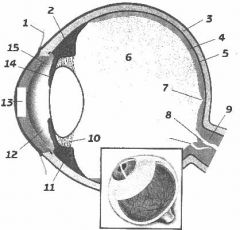
In addition to providing the eye with blood flow, this layer in many mammals is shiny to provide better light reception in low light.
|
|
|
6 the eustachian tube.
|
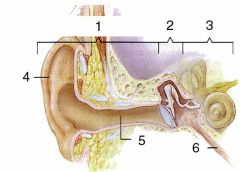
If a child has frequent ear infections, an artificial tube may inserted here to allow drainage. This tube is labeled
|
|
|
3 (the inner ear)
|
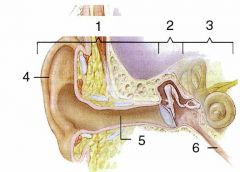
The region of the ear that is fluid filled is labeled
|
|
|
5, the vestibule.
|
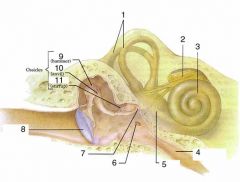
This area is reponsible for static equalibrium.
|
|
|
3 the cochlea.
|

This area contains the organ of corti.
|
|
|
9, 10, 11 (the ossicles)
|
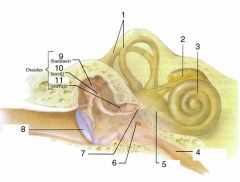
These structures can help prevent inner ear damage from loud sounds.
|
|
|
1, the semi-cirrcular canals.
|
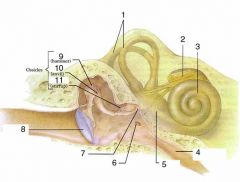
These structures are responsible for dynamic equalibrium
|

